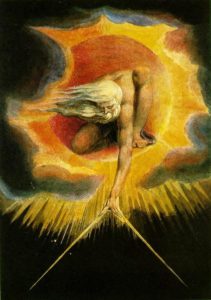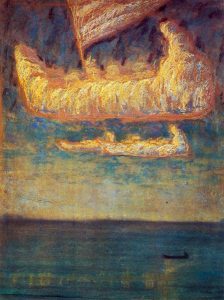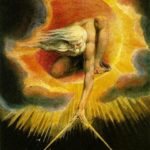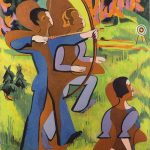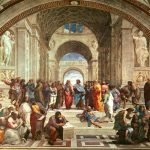Consciousness, Thought, and Truth
Our journey towards truth and understanding necessarily starts with an indissoluble problem: the nature of consciousness. If we want to have the slightest hope of understanding “truth,” we have to humble ourselves with the mystery of our subjective existence and its biological origins.
Perhaps the most obvious first step toward understanding this is to acknowledge what biological infrastructure we have that allows us to perceive and represent the world. What can biological science tell us of the nature of consciousness, perception, and attention? In this way we can see how the biological organism can start to approximate an idea of the world. Building on this, we can understand our cognitive capabilities as further adaptations to an increasingly complex environment.
As evidenced by this very investigation into truth, we come to yet another perplexing obstacle in which we realize our self-consciousness has uprooted the way see the world. And by adding language to that, the tools in which we represent truth, we find ourselves in a place where an infinitely complex reality is attempted to be seen with an infinitely flawed system.
At this point of hopelessness, we begin to discuss the way in which we can overcome these odds. Our best tool is the “intellect,” our skeptical, truth-seeking apparatus and see what it is missing: an ideal goal (which is clearly defined) and the means towards that goal. Defining Truth, as the goal of our intellect, is essential but by no means simple. And even once we have defined it, we are always tempted to become blind, satisfied, or disenchanted. Thus, we need also to have the appropriate attitude and method of finding, or rather approximating, Truth. With that, we gain what is often called wisdom.
Perception and Conception of Primary Consciousness
Consciousness may begin in a somewhat “blooming, buzzing confusion,” but our mind quickly grasps onto what is meaningful and most divisible. Our world is derived in a manner that is anything but straightforward. Being a biological creature nested in time and in an infinitely complex world, we divide experience into initial representations that play further roles in our conscious experience.
Our moving attention plays an essential role in creating the represented world. Attention shows us the dynamic between explored and unexplored territory and how our minds differentiate the two and use both to create our consciousness through time, using memory and present exploration.
Creating Mental Imagery
How we cut up the chaotic world into representations is anything but simple. One must first grapple with the idea of what is contained in a “piece” of the world. We are biological creatures and cannot assume that anything that we can represent evades biological meaning. From this, we can understand our perceptions as having much more meaning than the ostensibly neutral words that we use to signify the experience. We often make the mistake early on that we are trying to define ideas, when our subject is much more dynamic and complex.
Primary Consciousness
We shall start with the building blocks of perception, not in order to build up from “foundational” facts, but to realize that those basic elements are no more solid (or less enigmatic) than the assumptions that come later. The questions of consciousness are perhaps the most foundational of cognitive psychology, and for that reason, I think it ought to be treated as the basic problem of my explorations which the rest of these writings can subtly address.
Representational Learning
The division of the world into meaningful parts seems like a basic, non-emotional process; however, the way we see the world is not so obviously objective. Our sensory system can do some work without the influence of our states of motivation. However, all of what we represent maps onto our biology in actions, senses, or hitherto undefined biological ways. The organization of representations in our mind are not as things, but as meaningful relationships.
Attention in the Learning Process
Attention is directed in line with the metaphor of explored and unexplored territory. It seeks errors in the conception of the known, and it voluntarily explores new parts of the world in which opportunities or threats may arise. Because attention deals so strictly with actions—in fact it is an action—we learn to treat things more as an actionable unit than as an objective thing. Attention is a requirement for encoding and habituating to new information.
Ideas' Effect on Experience
After understanding how we have begun to perceive the world, we can begin to understand how we conceive the world, orienting perceptions in a way that maps meaning into the world so that perceptions can become ever more complicated and even begin to live on their own, as fantasies without external cause. But the encoding or this map of representation of the world also has greater complexity in how we define situations with layers of memory (long-term and working). The mapping of our minds is extremely complicated, especially when contending with time and the limited attention we have to devote to things. Selective attention becomes a highly important phenomenon.
Implicit Memory
Our implicit memory contains what is habitual and what is currently relevant. Our long-term memory tells us how to value the world and what things mean to us. Working memory prolongs activation in the mind do define what is relevant to the situation in which we must act. The best metaphor for what I describe is that of rivers carving out the land, making streams and canyons (long-term memory) and the quality and rate of flow that those carvings currently contain (working memory).
Stream of Consciousness
The role that our memories play is of helping us experience what is most important in any given moment. By encoding possible situations (from the past), we can react to them without hesitation and put our attention on what is novel. This is extremely important because we are so limited in time to perceive and react to things. Some amount of neurological preparation is necessary. The mode in which our attention moves will depend also on whether we are in a chaotic or predictable situation.
Secondary or Reflexive Consciousness
Something of an anomaly happened in the evolutionary process for human beings. At some point, human beings became self-conscious. We have become aware of our situation and have gathered foresight enough to frame things not in terms of present value, but in terms of tools for the future, for opportunities and protection from threat and loss. We have become able to shape ourselves according to a multitude of competing motivational factors weighed together by the ability to prolong attention.
With this, utterances become sophisticated language as part of those tools that opens up a world of abstract reasoning and intellect that is unparalleled in the animal kingdom. Understanding how these come about gets us somewhat closer to what we may come to understand as truth and wisdom.
Reflexive Consciousness
The next problem we have to contend with is how an animal has developed the ability to recognize itself and what that means for our perceptions and representations. What is highly involved in this is our need to look further into the future, creating the recognition of our ultimate vulnerability in the face of nature. We become aware of our need to prepare for many alternative outcomes. With this we are able to alter our attention, and therefore perceptions, according to what would be best in order to achieve long-term goals.
The Self-Conscious Animal
Having the foresight into the future allows us to realize our vulnerability. We recognize that we will face threats that we must prepare for and that we will eventually succumb to the ultimate result, death. But as a consequence of this foresight, we can ascribe meaning to things that make them useful in preparation for the future. If this mode of thinking is habituated to, this can result in us seeing things as equipment of value only for their use.
Consequences of Thought-as-Equipment
If we are able to see our own perceptions as tools for the future, we can also have the ability to control them as we world control a tool. The way we look at the world, particularly the values that information has, determines our entire perceptions of what is important. This is the precursor to spiritual self-change where we liberate our mind from its earlier patterns.
Language and Symbols
Until now, we have not necessarily discussed verbal thinking. This adds much more to the experience and result of our thought. Language allows us to reference things which are not present, or that are abstract and imperceptible. It is not surprising that language, as a medium through which culture speaks, can then influence how we think and understand the world.
Use and Invention of Language
In order to be consistent with the notion that we are primarily biological creatures we must view language as a social action—a very complex and coordinated one. We must not think of language as a truth-seeking device, but as cultural agreements on values. From their biological roots we can see how language is primarily used.
Language and Facilitation of Thought
It is no surprise that thinking is facilitated by language. Conscious thoughts, by their nature require some perceptible element, and often that is language. So the vocabulary and the imagined audience would play a large role in the paths one takes in thinking. With the word, a vague thought can linger in our mind long enough to have more significant affects, in effect, changing how we experience the stream of consciousness.
Symbols, Metaphors, and Myths
We cannot look at language as definitely aimed at understanding the world, but we also must accept language as our best medium through which we can find truths. With this we need to know how to use language to best achieve precision and accuracy. Language can be limited and deceptive in its representation of ideas, but recognizing this, broadening the usage of metaphor, and partaking in dialogue can mitigate the limitations of language.
Click edit button to change this text. Lorem ipsum dolor sit amet, consectetur adipiscing elit. Ut elit tellus, luctus nec ullamcorper mattis, pulvinar dapibus leo.
Truth, Wisdom, and Knowledge
“Capital T” truth is a distant standard for anyone to aim at, but when we see where we start from, with the nature of the intellect, and where we are going, with a defined goal of truth, we may be able to carve out our own paths to something resembling truth. What faculties we have, what we want to aim at, and how we can stay on the path towards that aim, can comprise the ultimate virtue of heroic wisdom which I hope to share and practice here.
The Intellect and Investigation
The intellect is the means in which we seek knowledge. It discovers and uncovers the deceptions of our perception, our language, and people who try to deceive us. Through a complex symbolic-linguistic structure that allows for logical computation and defining of situations, we have the freedom to believe more than what is ostensibly there. But wisdom and truth require more than a strong apparatus for understanding.
Demands of Truth
Because our intellect is not motivated to discover any truth that is beyond our social and self-interested motivations, we must conceptualize greater truths to aim at. The ideal of Truth will be the goal and the judge from which we can monitor our progression towards truth. This conception of truth however is not simple and entails and incredible amount of considerations. Ultimately, it is an ongoing process.
Wisdom
Wisdom is not a goal, but a method for which we seek truth. Faith, humility, and courage are required to take a heroic journey into chaos and come up with truth. These three qualities in which we must keep in mind to integrate ourselves with new, challenging information that can keep us on the path to truth.

